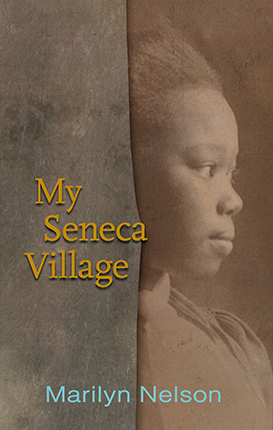| My Seneca Village Author: Nelson, Marilyn | ||
| Price: $19.06 | ||
Summary:
Quiet for more than 135 years, the voices of multi-ethnic, multi-racial Seneca Village are rising again. Angela Riddles ponders being free-but-not-free. The orphaned Donnelly brothers get gold fever. A conjurer sees past his era and into ours.
Reviews:
School Library Journal (+) (12/01/15)
The Bulletin of the Center for Children's Books (00/01/16)
Full Text Reviews:
Booklist - 09/01/2015 *Starred Review* Lest they be forgotten, the proud, multiethnic nineteenth-century society of Seneca Village is resuscitated through a divine medium: renowned American poet Nelson. Before New York made way for Frederick Law Olmsted’s grand Central Park design in 1858, African Americans, along with a few immigrant families, owned property there. Nelson whispers just enough background to connect the community members as she tenderly introduces the individual characters. Then each poem vibrantly and aptly speaks to that person’s life and place in the tableau. As more people’s lives are intertwined with the passage of time, Nelson’s Seneca Village becomes reminiscent of Edgar Lee Masters’ Spoon River. But while Masters structured his free-form narratives like epitaphs, Nelson brings her village to vivid life, using residents’ actual names gleaned from census records, while passionately imagining the modest pride and struggles of their daily lives. These masterfully written poems—fueled by events, laws, movements, and tragedies—are delivered mostly in quatrains to match each portrayal. Front and back matter describe the circumstances of the Seneca Village chronicle and poetic forms employed. An American saga so well suited to Nelson’s poetic touch is a gift meant to be gently unwrapped and read with an intellectually curious spirit ready for an awakening. - Copyright 2015 Booklist.
School Library Journal - 12/01/2015 Gr 5 Up—This beautifully crafted and powerful collection of poems deals with a brief period (1825–57) in New York City's storied past. Seneca Village, on Manhattan's Upper West Side, was a thriving multiethnic community of African Americans, Irish and German immigrants, and, possibly, some Native Americans, until it was decimated by the creation of Central Park. After poring over the written accounts and census records, renowned poet Nelson sat down to imagine the lives of a number of the residents, giving voice to individuals based on the names and identifying labels. Brief paragraphs set each scene, followed by a poem in the voice of the Seneca Villager. Readers hear from a bootblack, a conjure-man, a reverend, a hairdresser, a nurse, a mariner, schoolchildren, a music teacher, tub-men hauling sewage to the river, an elderly conductor on the Underground Railroad, and abolitionist and activist Maria W. Stewart. As in any impoverished community, the hardships are palpable—babies die of misunderstood diseases, people are victimized by their starving neighbors, there's violence and cruelty—but there is also resilience, hard-won independence, and hope for its children's futures. In the spirit of Edgar Lee Masters's Spoon River Anthology, this work touches on historical truths (footnoted throughout) but introduces a fleeting time and place through the everyday hopes and dreams of its residents. VERDICT This rich and diverse (a variety of poetic forms, including ones invented for certain speakers, are featured) piece of American literature belongs in every collection.—Luann Toth, School Library Journal - Copyright 2015 Publishers Weekly, Library Journal and/or School Library Journal used with permission.



